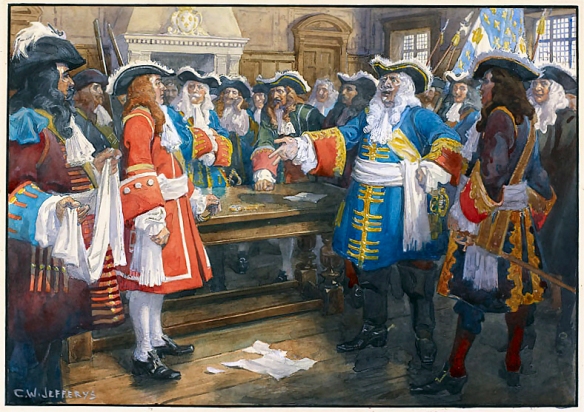“I have no reply to make to your general other than from the mouth of my cannons and muskets.” Frontenac famously rebuffs the English envoys.
ENGLISH SIEGE OF QUÉBEC, 1690 Naval power projection was crucial to successive English/British attempts to conquer French bases. Québec was established by the French in 1608, only to be starved into surrender by an English force in 1629, before being returned to the French in 1632 after a peace agreement. Larger British forces failed in their attacks in 1690 and 1711, the first in large part due to disease, the second due to a night-time shipwrecking. In 1759, British forces finally captured the city, with James Wolfe’s expeditionary force benefiting from a prior surveying of the St Lawrence River by James Cook.
Start Date: October 18, 1690
End Date: October 25, 1690
The first major English campaign during King William’s War (1689-1697), in October 1690. In response to French frontier raids, New York and New England organized a two-pronged invasion of New France. It combined a seaborne assault against Quebec with a secondary force advancing on Montreal from Lake Champlain. Massachusetts appointed Major General Sir William Phips commander of the Quebec expedition.
The New England colonies raised more than 2,300 men, but Phips waited in vain for additional supplies from England while the campaign season slipped away. Finally, on August 9, 1690, Phips and his army set sail for Quebec aboard 34 vessels. It was the largest colonial military expedition to that point.
In New France, Governor-General Louis de Buade, Comte de Frontenac, had left Quebec virtually undefended in order to stave off the English attack against Montreal. On October 10, when he learned of Phips’s departure, he raced back to Quebec with reinforcements, hoping to beat the English to the city. Fortunately, the British Army on Lake Champlain disbanded. This allowed Frontenac to shift nearly all his forces and call out the militia throughout the St. Lawrence River Valley.
Frontenac and the first reinforcements reached Quebec on October 14. Phips’s fleet arrived two days later. Quebec’s defenses grew stronger every day. Soon they boasted nearly 3,000 men.
Phips sent Major Thomas Savage ashore to demand Quebec’s immediate surrender. The French escorted the blindfolded officer into a main hall where Frontenac and an impressive retinue received him. An angry Frontenac rebuffed the English ultimatum, vowing that his cannon would bear his response.
French defiance presented a dilemma for the English. Colonial leaders had assumed the fleet’s mere presence would lead to capitulation. Phips and his officers then quickly improvised a plan to land forces east of Quebec and march overland to attack the city’s weak western defenses. Meanwhile, a small diversionary force would attack from the St. Lawrence.
On October 18, Major John Walley and 1,200 New Englanders landed along Beauport Flats on the St. Lawrence River’s north shore. They encountered little resistance, but illnesses, especially smallpox, kept the remaining troops on the transports. The only major obstacle, the St. Charles River, was fordable only for a few afternoon hours during low tide. Rather than attack the English across the river, Frontenac massed troops on the western shore. He planned to allow the English to cross the river, and when the tides rose cutting off reinforcements and retreat he would strike.
Four ships were to support the river crossing, but at dawn on October 19, Phips’s vessels dueled with French batteries instead. The exchange accomplished little except to expend most of the ships’ ammunition. Boats that were supposed to assist the crossing never arrived.
When a French deserter reported that the English were significantly outnumbered, Walley reassessed his situation. His men were exhausted, sick, frostbitten, and out of provisions. On October 20, Walley requested that his force be withdrawn. That night, as boats arrived to evacuate the provincials, panicked soldiers mobbed them and prevented an orderly withdrawal. Walley’s men would have to remain until the following evening.
After skirmishes on October 20 and 21, the English withdrew, leaving behind five of their six cannon. Unaware at first of the New Englanders’ flight, Frontenac missed a potential opportunity to destroy the provincial force. Nevertheless, his defensive strategy had succeeded, with minimal French losses.
Phips and his officers debated another landing, but a storm scattered the fleet. Facing serious food and ammunition shortages, smallpox, and the coming winter, Phips negotiated a prisoner exchange. On October 25, he sailed for home. Both sides had suffered about 30 casualties. But a series of shipwrecks and disease pushed the English casualty total to well over 400, not including the smallpox outbreak triggered by the fleet’s return. Even worse, the venture was a financial disaster because the colonies planned to recoup the over £50,000 investment through the looting of Quebec. With little effort, the French had repulsed the poorly planned, indifferently led English expedition. The failure soured many colonial leaders on future ventures that lacked significant support from the Crown.
References Baker, Emerson W. The New England Knight: Sir William Phips, 1651-1695. Toronto: University of Toronto Press, 1998. Eccles, William J. Frontenac: The Courtier Governor. Toronto: McClelland & Stewart, 1959. Leach, Douglas Edward. Arms for Empire: A Military History of the British Colonies in North America. New York: Macmillan, 1973. Stacey, C. P. Introduction to the Study of Military History for Canadian Students. Ottawa: Queen’s Printer, 1964.
